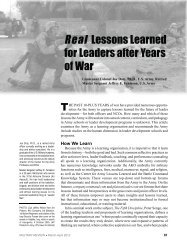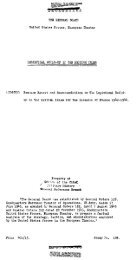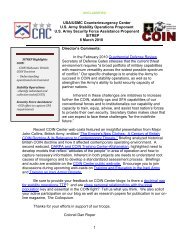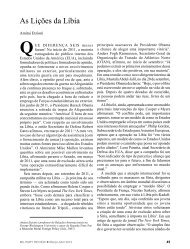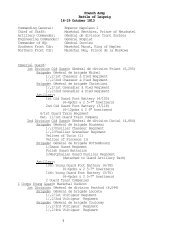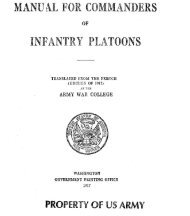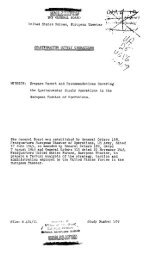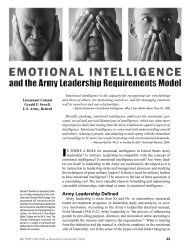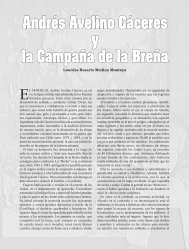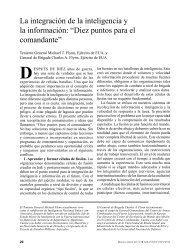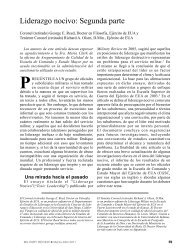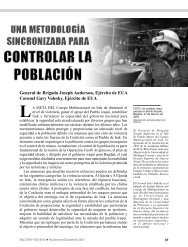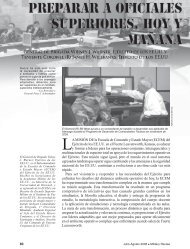Armor Magazine Counterinsurgency Selected Works - US Army
Armor Magazine Counterinsurgency Selected Works - US Army
Armor Magazine Counterinsurgency Selected Works - US Army
You also want an ePaper? Increase the reach of your titles
YUMPU automatically turns print PDFs into web optimized ePapers that Google loves.
Welcome to the<br />
<strong>Counterinsurgency</strong> Century<br />
As this is written, we are but a few steps into the 21st century.<br />
It does now appear that it may one day be characterized as the<br />
“counterinsurgency century.” What might that portend?<br />
The 21st century, even in its infancy, is obviously quite complex;<br />
perhaps even far more complex than the worlds of the<br />
19th and 20th centuries, both of which were characterized by<br />
warfare, largely between nation states, in conflicts resulting in<br />
frightening losses in human resources, as well as other national<br />
treasure; indeed the loss of entire nation states, as well as the<br />
catastrophic devastation of others — even those said to have<br />
“won” the war.<br />
by Retired General Donn Starry<br />
To illustrate the complexity thesis, consider the French experience<br />
post-1939-1945, as Japanese forces withdrew and the French<br />
attempted to reestablish control over their territorial holdings in<br />
what was once called “French Indochina.” It was here that the<br />
French army was confronted by a considerable and well-developed<br />
communist underground who aimed to spread communist<br />
governance into Indochina, thus beginning counterinsurgent warfare<br />
against the Viet Minh.<br />
French army forces deployed to Indochina were far too few and<br />
not adequately equipped to accomplish their assigned mission.<br />
Recognition of those inadequacies caused French army commanders<br />
on the ground to petition the home government<br />
for more units, weapons capabilities,<br />
and support to match. Their petitions<br />
were largely ignored or outright denied.<br />
The best and most relevant histories<br />
of this period are set forth in Bernard<br />
Fall’s books, Street without Joy<br />
and Hell in a Very Small Place. Both<br />
have been extensively read by those<br />
attempting to characterize counterinsurgency<br />
war fare in Vietnam, as<br />
they represent preludes to what took<br />
place after the Geneva Accords were<br />
signed in 1954, and, at the time, at<br />
least token U.S. involvements in Vietnam<br />
began.<br />
Surrendering at Dien Bien Phu, the<br />
French army leadership considered the<br />
rug pulled from beneath them by their<br />
political masters, who, from the soldiers’<br />
viewpoint, had neither tried to<br />
understand the situation nor respond<br />
to the entreaties of on-site commanders<br />
for help. The army literally<br />
withdrew into seclusion in army<br />
schools and colleges to begin the<br />
construct of a relevant counterinsurgency<br />
doc trine — at strategic,<br />
operational, and tactical levels in<br />
an attempt to determine what they<br />
should have done, strategically, operationally,<br />
and tactically; what had<br />
gone wrong; and how they might have<br />
done better.<br />
Over the next few difficult years, they fashioned<br />
an operational concept titled La Guerre<br />
Revolutionaire, which included concepts for strategy,<br />
campaign, and tactical operations. With its new<br />
operational concept, the French army went to war<br />
once again in a French colonial holding where there<br />
was a mounting insurgent movement. It was, however,<br />
an involvement quite different from that in<br />
Indochina. Algeria had in fact been a French colonial<br />
holding; however, it was to most French people<br />
part of the homeland — metropolitan France. It<br />
6 — September-October 2008



